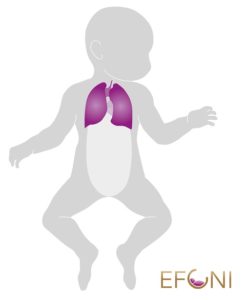Some babies born too early show signs and symptoms later in life that may be long-term consequences of preterm birth. To look at this in more detail, follow-up studies are of great importance. Their results provide a scientific basis for follow-up and continuing care. A study from Sweden recently analysed lung function in 6½-year-old children born at less than 27 weeks. These extremely preterm born children had suffered from immature lungs after birth, and almost all of them had developed Bronchopulmonary dysplasia (BPD), a chronic neonatal lung disease.
 In total, 178 children from the Swedish national cohort study EXPRESS (Extremely Preterm Infants in Sweden Study) agreed to participate in the follow-up study on lung function (71% inclusion rate). Each of these children was matched to a healthy control born at term, based on date of birth, hospital of birth, sex, and mother’s country of birth. The idea behind such a matched case-control follow-up study design is to compare a specific condition (here: lung function) in two groups that differ in one characteristic (here: preterm birth versus full-term birth) but are otherwise as similar as possible.
In total, 178 children from the Swedish national cohort study EXPRESS (Extremely Preterm Infants in Sweden Study) agreed to participate in the follow-up study on lung function (71% inclusion rate). Each of these children was matched to a healthy control born at term, based on date of birth, hospital of birth, sex, and mother’s country of birth. The idea behind such a matched case-control follow-up study design is to compare a specific condition (here: lung function) in two groups that differ in one characteristic (here: preterm birth versus full-term birth) but are otherwise as similar as possible.
All children from both the extremely preterm and the full-term groups were invited to do clinical and lung function assessments. Six controls were unable to reach or declined, resulting in a control group of 172 children.
Among the children born extremely preterm, 40% reported respiratory wheeze or the use of asthma medication in the last 12 months. In the control group, this percentage was significantly lower with only 15%. The results of the lung function tests showed that the children born extremely preterm had reduced lung function compared to the controls. Functional deficits included reduced maximal expiratory flows, lower lung volumes, and altered airway mechanisms. Furthermore, children born at 22-24 weeks of gestation had a 5-10 times increased risk to have a lung function below the lower limit of normal compared to the control group.
A comparison of lung function of preterm born children with BPD and without BPD was not possible to perform. As 90% of the children born extremely preterm suffered from moderate or severe BPD in the neonatal period, the group of children without BPD in the neonatal period would have been too small and the group sizes too unequal for statistical analyses.
The findings of the study suggest that preterm birth and the level of preterm birth have an effect on lung function in childhood. They also provide indications that follow-up and continuing care is necessary not only during but also beyond childhood, to detect and track further long-term outcomes.
Read the original study (Pediatric Pulmonology)

